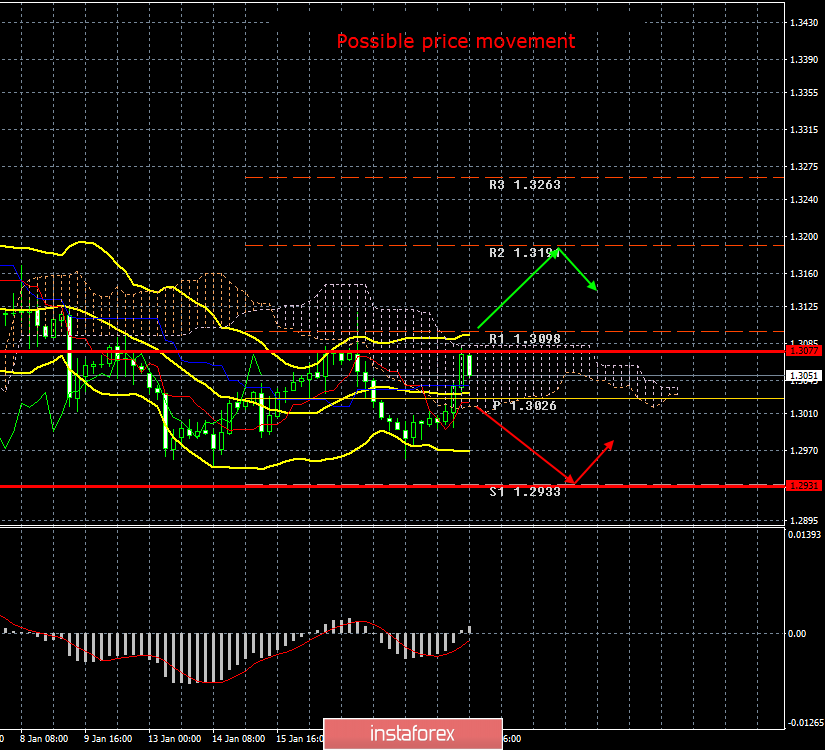4-hour timeframe

Amplitude of the last 5 days (high-low): 79p - 58p - 57p - 115p - 52p.
Average volatility over the past 5 days: 73p (average).
The British pound on Tuesday, January 21, as well as the euro, adjusted most of the day. The pound/dollar pair managed to enter the Ichimoku cloud and work out its upper boundary, which could not be overcome the first time. At the moment, we can state a rebound from the Senkou Span B line, which can return the pair to a downward channel. The upper line of the volatility channel was also worked out - the level of 1.3077, from which a rebound also occurred. As a result, at the moment, we can say that the prospects for upward movement in the British currency remain very vague. Bulls remain extremely weak. Quotes fail to overcome key resistance levels on their way up. Thus, if the pair regains consolidation below the critical Kijun-sen line, we can conclude that the downward trend will resume. Or downward movement, at least to the lower Bollinger band.
Today's macroeconomic statistics came down to publications in the UK. Here, three macroeconomic reports were published immediately, from which traders finally expected not disastrous values. Despite the current weakness of the British economy, wages have shown steady growth since 2017, so this indicator did not cause much concern. And so it turned out in practice. The average salary including bonuses showed an increase of 3.2% with a forecast of 3.1%. Without premiums - 3.4% with a similar forecast. More attention was focused on the unemployment benefit application rate, which was also "on top", amounting to only 14,900 with expert forecasts of 22,600. The unemployment rate was expected to remain unchanged at 3.8%. Thus, today's package of macroeconomic statistics turned out to be positive for the first time in a long time. The pound has received the support of market participants, but we believe that key indicators of the British economy remain extremely weak, reports on wages and unemployment are clearly not enough to count on an upward trend for the pound.
Meanwhile, the pun in the British Parliament continues, however, this time without consequences. Immediately after the party of Boris Johnson won the election in December, the fate of Brexit was considered decided. The Conservative party won a majority in the Lower House of Parliament, respectively, no longer depended on the opposition forces and voted for the "deal" between Boris Johnson and the EU without problems. It would seem that only formalities remained: the approval of the same deal by the European Parliament (which there is no point in blocking this agreement) and its approval by the House of Lords. And it turned out that the House of Lords, in which Johnson does not have a majority, refused to accept the agreement with the EU, making amendments to some points. In particular, we are talking about the need for a physical document for EU residents to legally reside in the UK, as well as for depriving ministers of the right to decide which decisions of the European Court will be rejected by local courts. In general, the bill returns to the House of Commons, where another vote will take place, which may block the demand of the House of Lords by a simple majority.
The technical picture of the currency pair remains essentially the same. The pair failed to gain a foothold above all the lines of the Ichimoku indicator, therefore, upward prospects are still absent. We expect the resumption of the downward movement to the support level of 1.2933. Only overcoming the Senkou Span B line and the first resistance level of 1.3098 can contribute to the formation of a new upward trend, however, fundamental factors remain not on the side of the British pound. The country is still moving into the future without the EU and is already suffering enormous financial losses due to this gap. In 2020, the situation is unlikely to change. Although Donald Trump announced a trade agreement with Great Britain during his speech at the Davos International Economic Forum, while calling Johnson "smart," this does not mean that this deal will be signed in the near future. The Bank of England is still looking to lower the key rate, and its head Mark Carney resigns.
Trading recommendations:
GBP/USD remains downside. Thus, traders are advised to resume sales of the pound/dollar pair with the target of 1.2933, after the correction is completed and the pair is consolidated below the Kijun-sen line. It is recommended that purchases of British currency be returned no earlier than the price consolidation above the Senkou Span B line and the level of 1.3098 with the first target of 1.3191.
Explanation of the illustration:
Ichimoku indicator:
Tenkan-sen is the red line.
Kijun-sen is the blue line.
Senkou Span A - light brown dotted line.
Senkou Span B - light purple dashed line.
Chikou Span - green line.
Bollinger Bands Indicator:
3 yellow lines.
MACD indicator:
Red line and bar graph with white bars in the indicators window.
Support / Resistance Classic Levels:
Red and gray dashed lines with price symbols.
Pivot Level:
Yellow solid line.
Volatility Support / Resistance Levels:
Gray dotted lines without price designations.
Possible price movements:
Red and green arrows.





















